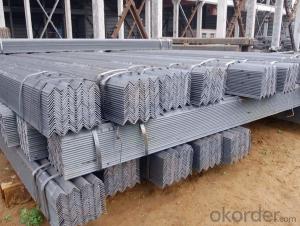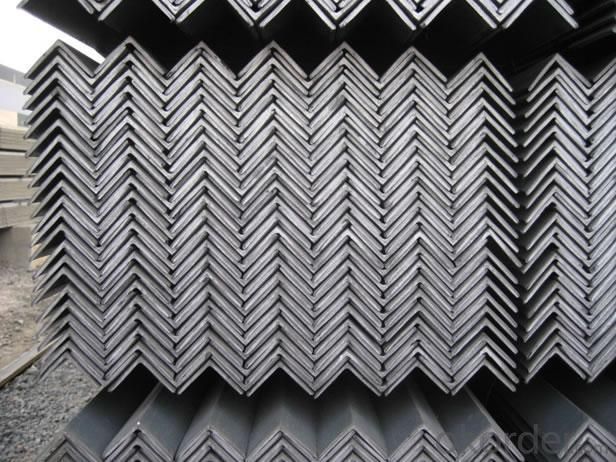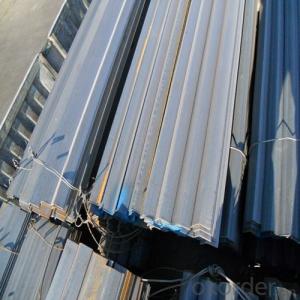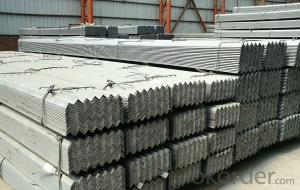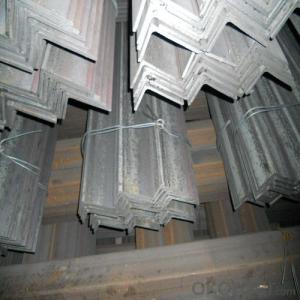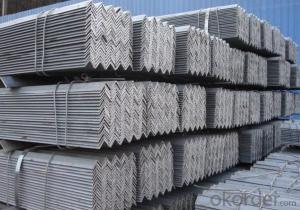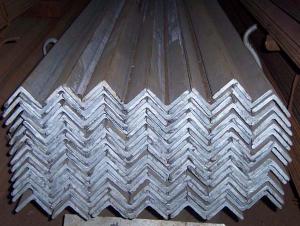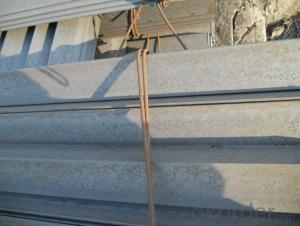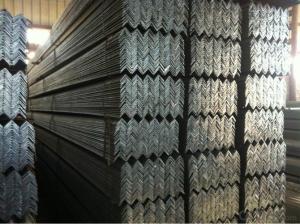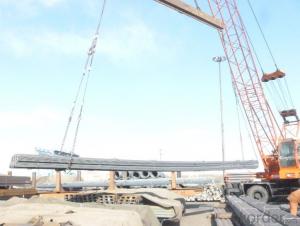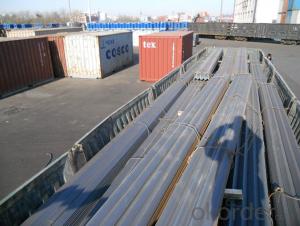high quality equal angle
- Loading Port:
- China Main Port
- Payment Terms:
- TT OR LC
- Min Order Qty:
- -
- Supply Capability:
- -
OKorder Service Pledge
OKorder Financial Service
You Might Also Like
ROUND BAR Details:
| Minimum Order Quantity: | | Unit: | m.t. | Loading Port: | |
| Supply Ability: | | Payment Terms: | | Package: | wire bundle |
Product Description:
Specifications of Wire Rod Q235:
Steel Grade: Q235, Standard: GB Diameter: 5.5mm, 6.5mm, 7mm,8mm,9mm,10mm,12mm,14mm
Diameter Tolerance:±0.3mm 6.5mm can be drawing into 2mm/8.0mm can be drawing into 3mm
Brand Name: N-RIVER Place of Origin: Hebei, China Mainland Application: construction, building etc
Chemical Composition:
Please kindly find our chemistry of our material based on Q235 as below for your information
Trademark | Rank | Chemical composition (quality score) % | | ||||
C | Si | Mn | S | P | | ||
| | |||||||
| ≤ |
| ≤ | ≤ | | ||
Q235 | A | 0.14-0.22 | 0.30 | 0.30-0.65 | 0.050 | 0.045 | |
Q235 | B | 0.12-0.20 | 0.30 | 0.30-0.70 | 0.045 | 0.045 | |
Trademark | Rank | Pulling Test | | ||||
Bend PointΔs/Mpa | Tensile Strength | Elongation Ratioδ5% | | ||||
| | |||||||
Thickness (Diameter) /MM | Thickness (Diameter) /MM | | |||||
≤16 | 16-40 | | ≤16 | 16-40 | | ||
≥ | | ≥ | | ||||
Q235 | A | 235 | 225 | 375-500 | 26 | 25 | |
Q235 | B | 235 | 225 | 375-500 | 26 | 25 | |
Usage and Applications of Wire Rod Q235:
After hot-rolled the products shaped into coil and delivery as finished product, including round, square, rectangular, hexagonal and so on. Since most of the products are round, it is generally called wire rod. Carbon steel wire rod is widely used in construction and manufacturing. Carbon steel wire rod is mainly used for reinforcement of reinforced concrete and welded structure or reprocessed (roberts , nail, etc.) materials, especially used to produce wire drawing, welding electrode, nails, spring, electronic, precise machinery parts and so on.
Packaging & Delivery of Wire Rod Q235:
Packaging Detail: products are packed in coil and then shipped by container or bulk vessel
Each coil weight: 2-3MT
Delivery Detail: within 45 days after received deposit or LC.
Label: to be specified by customer, generally, each bundle has 1-2 labels
Trade terms: FOB, CFR, CIF
- Q: Can steel angles be used for pipe supports or hangers?
- Yes, steel angles can be used for pipe supports or hangers. Steel angles provide structural support and stability for pipes, making them suitable for various applications in the construction and industrial sectors. The L-shape design of steel angles allows for easy attachment to walls, ceilings, or other structural members, providing a sturdy base for suspending or supporting pipes. Additionally, the strength and durability of steel angles make them capable of withstanding the weight and pressure exerted by the pipes, ensuring long-term stability and reliability. Overall, steel angles are a commonly used and effective choice for pipe supports and hangers.
- Q: Can steel angles be used in seismic-resistant structures?
- Seismic-resistant structures can incorporate steel angles for various purposes. These versatile elements are commonly utilized in buildings and bridges due to their high strength. In seismic-resistant structures, steel angles can be employed in multiple ways to bolster the overall structural integrity and earthquake resistance. When used as bracing elements, steel angles play a crucial role in distributing and dissipating seismic forces. By connecting them diagonally between different structural components, the impact on the structure can be significantly minimized. This prevents excessive deformation or collapse during an earthquake. Moreover, steel angles can reinforce and strengthen key components of the structure. They can be welded or bolted to beams and columns, providing additional support and stiffness. This reinforcement enables the structure to better withstand lateral forces generated by earthquakes, ultimately improving its seismic performance. In the construction of moment-resisting frames, steel angles are essential components. These frames are widely employed in seismic-resistant structures. By utilizing steel angles as the main elements, rigid connections between beams and columns are created. This allows for effective transfer and distribution of seismic forces, reducing structural damage and enhancing earthquake resistance. It is important to adhere to relevant building codes and regulations when incorporating steel angles into seismic-resistant structures. The specific design and detailing requirements may vary depending on the seismic zone and potential earthquake magnitudes. Consulting with structural engineers and following appropriate guidelines is crucial to ensure the safe and effective utilization of steel angles in these structures.
- Q: What are the common bending or forming processes used for steel angles?
- Steel angles can be bent or formed using different processes, depending on the desired shape and specifications. Roll bending is a common process that gradually bends the steel angle using a series of rollers. This method is ideal for larger angles and ensures precise and consistent bending. Press braking is another popular process, where a punch and die apply significant force to bend the steel angle into the desired shape. This versatile method can be used for both small and large angles, allowing for various bending angles and shapes. Hot bending involves heating the steel angle to a high temperature and then using specialized equipment to bend it into the desired shape. This method is suitable for larger angles and allows for more complex bending shapes. Cold bending, on the other hand, is a cost-effective and efficient process for smaller angles. It involves bending the angle using force without the need for heating, making it a convenient option for achieving simple bending shapes. In conclusion, the choice of bending or forming process for steel angles depends on factors such as size, thickness, shape requirements, cost, and production efficiency.
- Q: How do you determine the required size of a steel angle for a specific application?
- To determine the required size of a steel angle for a specific application, there are several factors that need to be considered. These include the load or weight that the angle will be supporting, the span or distance between supports, and the material properties of the steel angle. Firstly, it is crucial to determine the load or weight that the angle will be subjected to. This can be done by calculating the total load that will be applied to the angle, including the weight of any objects or structures that will be supported by it. It is important to account for both static and dynamic loads, as well as any potential impact or wind loads that may be present. Secondly, the span or distance between supports needs to be considered. This is the length over which the angle will be spanning and supporting the load. Longer spans typically require larger and stronger angles to ensure structural integrity. Additionally, the material properties of the steel angle play a significant role in determining its required size. Steel angles come in various grades and strengths, each with different load-bearing capacities. It is essential to consult engineering and design codes, such as the American Institute of Steel Construction (AISC) Manual, to determine the appropriate grade of steel angle that can withstand the calculated load. Once the load, span, and material properties have been determined, engineering calculations can be performed to select the required size of the steel angle. These calculations typically involve evaluating the moment, shear, and deflection of the angle under the applied load. The AISC Manual provides design tables and equations that can be used to determine the appropriate size and shape of the angle based on these calculations. In conclusion, determining the required size of a steel angle for a specific application involves considering the load, span, and material properties of the angle. By performing engineering calculations and referring to design codes, the appropriate size of the angle can be selected to ensure structural safety and integrity.
- Q: What are the common methods of surface finishing for steel angles?
- There are several common methods of surface finishing for steel angles, depending on the desired aesthetic and functional properties. These methods include: 1. Painting: Painting is one of the most common methods of surface finishing for steel angles. It involves applying a protective coating of paint to the surface to prevent corrosion and enhance its appearance. Different types of paint, such as epoxy, acrylic, or powder coatings, can be used based on specific requirements. 2. Galvanizing: Galvanizing is a popular method for protecting steel angles from rust and corrosion. It involves immersing the steel angle in a bath of molten zinc, which forms a protective layer on the surface. Galvanizing is particularly effective for steel angles exposed to harsh environments or outdoor applications. 3. Powder coating: Powder coating is a process where a dry powder is electrostatically sprayed onto the steel angle and then cured in an oven. This results in a durable and attractive finish that provides excellent resistance to chipping, fading, and corrosion. Powder coating is commonly used when a thicker, more robust finish is desired. 4. Anodizing: Anodizing is a surface finishing process mainly used for aluminum, but it can also be applied to steel angles. It involves creating an oxide layer on the surface of the metal through an electrochemical process. Anodizing provides increased corrosion resistance and can also be used to add color to the steel angle. 5. Shot blasting: Shot blasting is a method of surface preparation that involves bombarding the steel angle with small steel shots at high velocity. This process helps to remove rust, mill scale, and other impurities from the surface, leaving it clean and ready for further finishing processes such as painting or galvanizing. 6. Polishing: Polishing is a surface finishing technique that involves mechanically smoothing and shining the steel angle's surface. This process is typically used to achieve a reflective, mirror-like finish or to remove surface imperfections. These are some of the common methods of surface finishing for steel angles, each offering different benefits and suitable for various applications. The choice of method depends on factors such as the desired appearance, environmental conditions, and specific performance requirements.
- Q: What are the different types of connections used for steel angles?
- There are several types of connections used for steel angles, including bolted connections, welded connections, and riveted connections.
- Q: Are steel angles susceptible to fatigue failure?
- Indeed, steel angles can experience fatigue failure. This failure occurs when a material undergoes repeated cycles of loading and unloading, resulting in the development and spread of cracks within the material. Similar to other structural components, steel angles can be exposed to cyclic loading conditions, such as vibrations, oscillations, or repeated stress applications. Multiple factors influence the occurrence of fatigue failure in steel angles, including the properties of the material, the geometric shape of the angle, the magnitude and frequency of the applied loads, and the presence of any defects or stress concentrations. Notches, welds, or sharp corners can particularly act as stress raisers, leading to localized stress concentrations and potential sites for crack initiation. To mitigate the risk of fatigue failure, engineers and designers consider various strategies. Firstly, they thoroughly assess the anticipated loading conditions and incorporate appropriate safety factors into the design to ensure that the steel angles do not experience stress levels surpassing their fatigue strength. Secondly, they strive to minimize stress concentrations through proper design techniques, such as incorporating rounded corners or fillets, which help distribute stress more uniformly and decrease the likelihood of crack initiation. Additionally, regular inspection and maintenance of structures play a crucial role in identifying potential fatigue cracks, enabling necessary repairs or replacements.
- Q: Can steel angles be used for playground equipment?
- Yes, steel angles can be used for playground equipment. Steel angles provide strength, durability, and stability, making them suitable for various playground structures such as swing sets, climbing frames, and slides.
- Q: How are steel angles protected during transportation and storage?
- To ensure the preservation and quality of steel angles during transportation and storage, various measures are taken. One commonly employed method involves the application of a protective coating or paint to the surfaces of the steel angles. This coating acts as a barrier, shielding the angles from moisture and preventing the occurrence of rust and corrosion. Moreover, plastic wrapping or tarp covering can be utilized to safeguard the angles against dirt, dust, and other contaminants. During transportation, the risk of shifting or falling is minimized by securing the steel angles in bundles or arranging them in a manner that reduces such hazards. Additionally, pallets or skids may be employed to facilitate handling and prevent direct contact with the ground. When stored, it is crucial to keep the steel angles in a well-ventilated and dry area in order to prevent the accumulation of moisture. Furthermore, proper labeling and handling instructions play a vital role in preventing mishandling or damage during transportation. This entails the use of appropriate lifting equipment and avoidance of rough handling that could potentially lead to bending or deformation. By implementing these protective measures, the integrity and quality of steel angles can be upheld throughout the transportation and storage processes, ensuring their readiness for use.
- Q: Can steel angles be used as structural supports?
- Indeed, structural supports can be provided by steel angles. Construction and engineering projects frequently employ steel angles due to their remarkable strength and stability. Their distinctive L-shape design renders them perfectly suited for lending support and ensuring structural integrity to various structures. Buildings, bridges, and other infrastructure projects often incorporate steel angles as beams, braces, or supports. These angles are capable of bearing heavy loads and resisting bending and compression forces, thereby establishing themselves as a dependable choice for structural support. Moreover, the ease of fabrication and installation associated with steel angles renders them a cost-effective solution for construction purposes.
Send your message to us
high quality equal angle
- Loading Port:
- China Main Port
- Payment Terms:
- TT OR LC
- Min Order Qty:
- -
- Supply Capability:
- -
OKorder Service Pledge
OKorder Financial Service
Similar products
Hot products
Hot Searches
Related keywords
